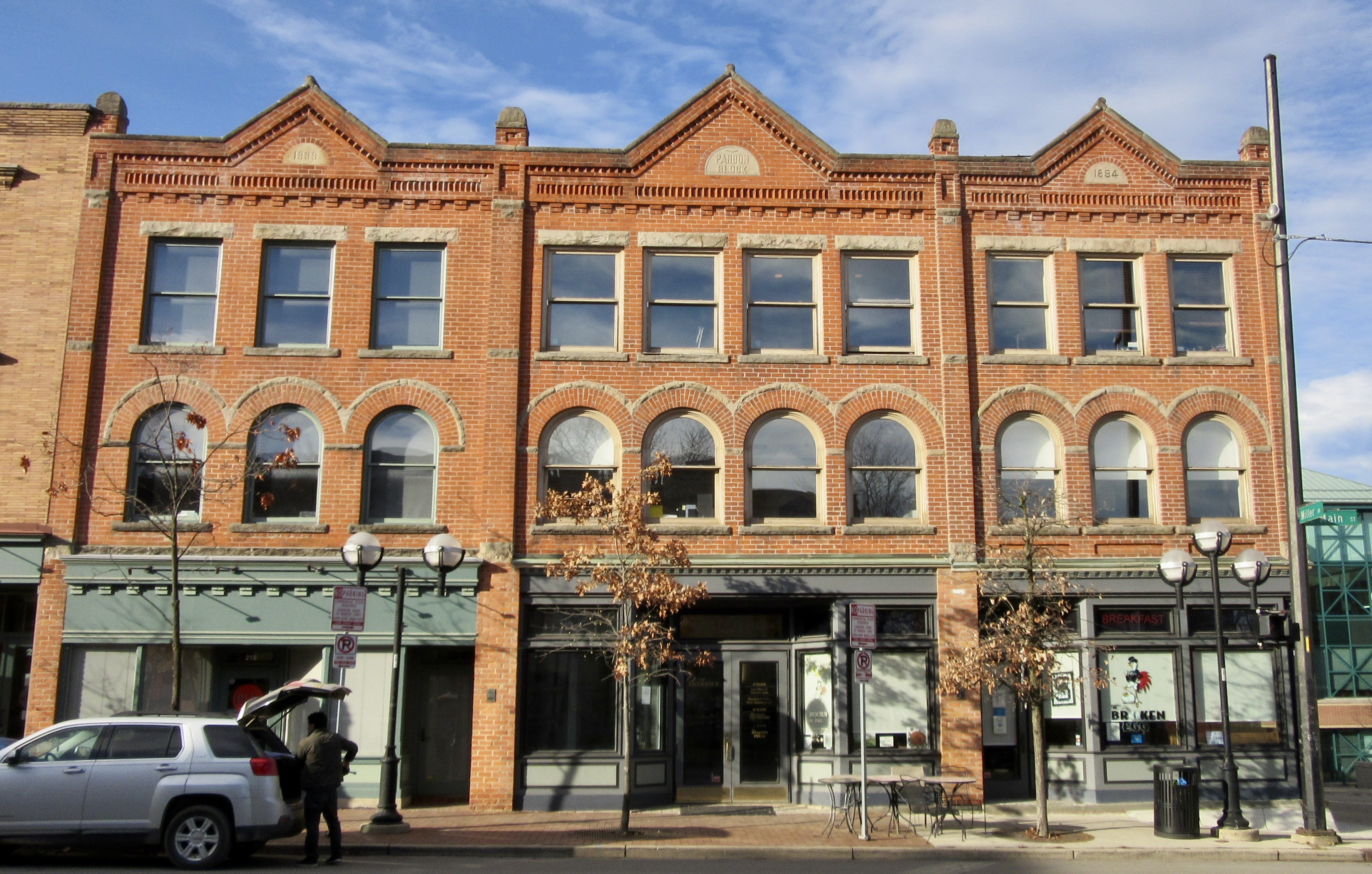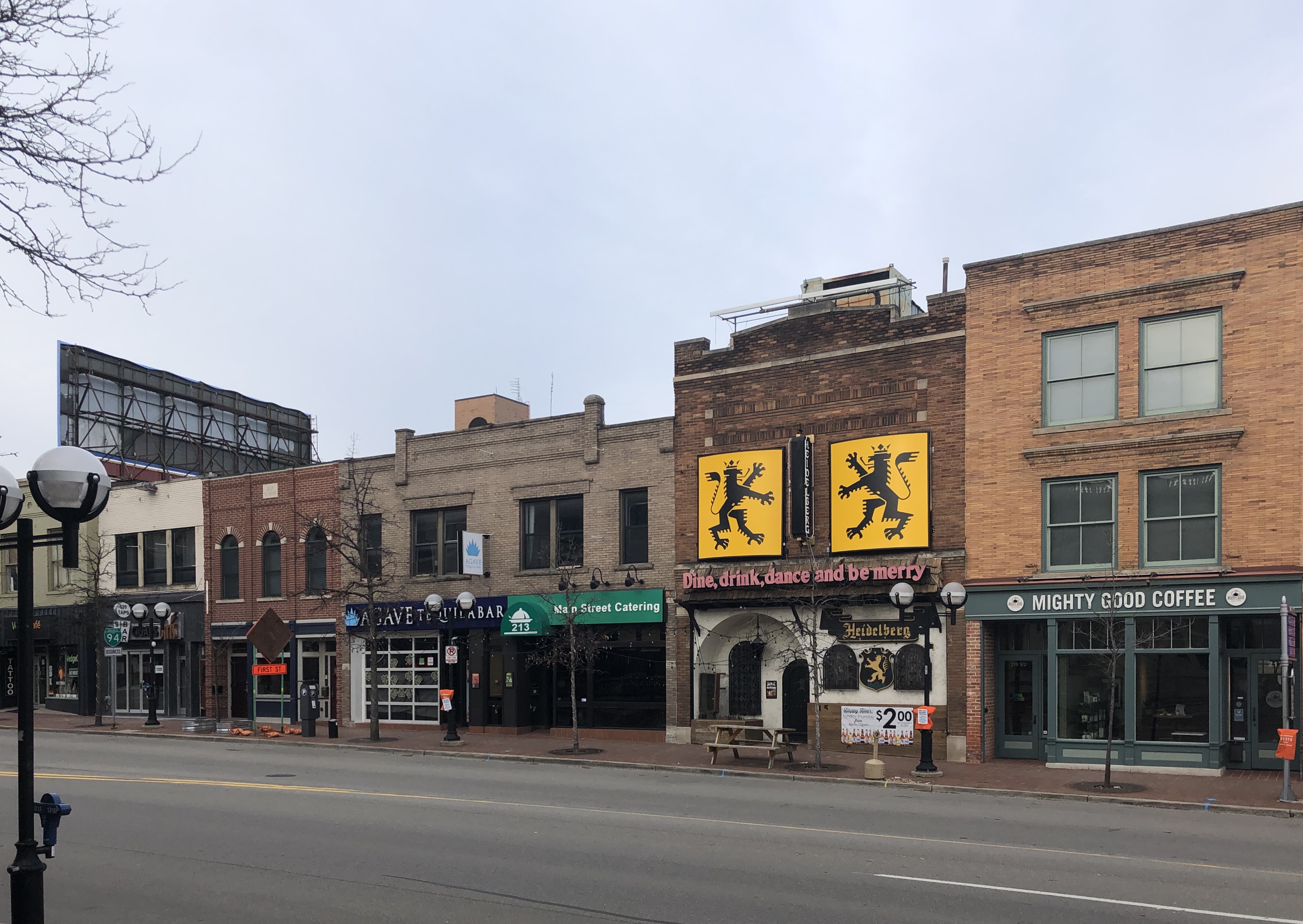Buildings, Pardon Block, 219-223 N Main St, December 23, 2020 Photographer: Steve Jensen

Year:
2020
North Main St, 200 Block, Looking West: Pardon Block, Broken Egg Restaurant, Mighty Good Coffee, Ply ArchitectsNorth Main Street, 200 Block, Looking West: , April 14, 2020 Photographer: Amy Cantu

Year:
2020
North Main St, 200 Block, Looking West: Pardon Block, Heidelberg Restaurant, Main Street Catering, Agave Tequila Bar, 209 Fitness, Siris Restaurant and Cigar Bar, Vedge Cafe, April 14, 2020 Photographer: Amy Cantu

Year:
2020
The Pardon Block
A family of butchers left a monument on Main Street Nineteenth-century immigrant families were generally very close-knit, with relatives living near one another and working in similar professions. Consider Ann Arbor's Pardon family, builders of the Pardon Block on the southwest corner of Main and Miller. Seven of the eight children of Edward C. and Wilhelmina Pardon, who immigrated to Ann Arbor from Germany in 1857, were connected to the meat business: three of their four sons became butchers, and all four of their daughters' husbands were butchers or worked in meat markets. The fourth son was a baker--but his bakery was also in the Pardon Block. Ironically, Edward C. Pardon himself was a tailor. He worked for Wagner and Co. on Main Street before going into business for himself. The family lived on the southeast corner of Fountain and Summit (then called High Street), until moving to Pittsfield Township in 1875. The family's switch to the meat business appears to be an accident of marriage. In 1883, the oldest Pardon daughter, Hulda, married John Schneider, a butcher with a shop at 213 North Main. According to Samuel Beakes's 1906 Past and Present of Washtenaw County Michigan, Schneider trained Hulda's younger brother Charles as a butcher. Very likely, he also trained another of Hulda's brothers, William, who fell between Hulda and Charles in age. The butchers in Ann Arbor must have all known each other and probably socialized together. At any rate, two of Hulda's sisters, Wilhelmina and Emma, followed her example and married butchers: Wilhelmina, called Minnie, married Charles Lutz in 1885, while Emma married Jack Eschelbach in 1891. Lutz eventually took over Schneider's store on Main Street; Eschelbach had his own shop at 202 East Huron. The youngest sister, Clora, married Lyman Hebbard, who worked at a number of area grocery stores. Hebbard, too, eventually wound up in the meat business, working for Charles Pardon. William was the first Pardon to have his own store, opening a grocery and meat market at 123 East Liberty in 1892. Two years later, Charles returned to Ann Arbor after six years in South Lyon to build his own meat market at 223 North Main, at the corner of Miller. He is described in Beakes's book as having "an extensive business, drawing his patrons from among the best class of citizens." Beakes adds that Charles's "well directed activity and unremitting energy have made him a prosperous merchant." In 1899, Charles added two more buildings to the west to create the present Pardon Block: 219, 221, and 223 North Main. Preservation architect Dave Evans, whose offices are in the Pardon Block, believes it's possible Charles bought existing buildings and then altered them to match his original storefront: he notes that although the detailing on all three storefronts is the same, they have different widths. According to the 1900 Ann Arbor Industrial Edition, Charles bought up the stock of J. H. Miller, a grocer at 221 North Main, and created a combined grocery and meat market in the two storefronts. He also bought the stock of Eberhart bakery and sold it to his youngest brother, Frank, who moved that business into the block's southernmost storefront. Like his two brothers, Frank lived above his store with his family. In 1893, the oldest son in the Pardon family, Edward J., bought about six acres of land fronting Summit between Miner and Fountain, close to where he'd grown up. Although his holdings were not really big enough to be called a farm, for a while he was able to piece together a living from his land: he had a garden, a large flock of chickens, a team of horses, and a milking cow. Taking advantage of a large hill of sand on the property, on Summit near Miner, he also sold and delivered sand to area masons. But eventually the sand hill was gone, and Edward Pardon hired on with his brother Charles to be a sausage maker in his meat market. Thus, by the turn of the century, the four Pardon brothers and their four brothers-in-law all worked in the food business in downtown Ann Arbor. But this situation did not last long. First William and then Charles left their businesses to work in packinghouses. Charles got a job at a Flint packinghouse, then returned to Ann Arbor as the manager of the Hammond Beef Company at 233 Depot. William temporarily retired to Whitmore Lake to farm but returned in about 1912 to start his own business, the Ann Arbor Packing Company, at 221-229 East Summit. Frank also left his bakery business, the family story being that he was allergic to flour. He joined the Ann Arbor Police force, rising to become chief, but died in 1916 of injuries sustained in a student riot. Even after their stores closed, Pardon family members kept working for one another. Edward followed Charles to Hammond, again working as a sausage maker. (He later told his grandson, Richard Pardon, that the only way he could tell whether the sausage was seasoned right was to taste it, which meant he had to eat raw meat.) After William started his packing company, Charles left Hammond and came to work for him, serving as treasurer and manager. William stayed in the business for twenty-five years, and many of the next generation of Pardons worked there filling jobs such as bookkeeper, driver, secretary/treasurer, and vice-president. William eventually sold his business to Peter's Sausage Company, and today the land is part of Wheeler Park. At age sixty-two, Edward J. Pardon went into home building, developing five houses on his property--three on Summit and two on Miner--which he rented out. He built the last one, on the corner of Fountain and Summit, when he was seventy-two. Charles and William, no longer having stores to live above, also moved back to the old neighborhood, into houses on Spring Street. Richard Pardon remembers, "There was a path all worn down connecting the family houses. They went through fields rather than on the street to get to each other." The Pardon Block kept its original uses under different owners through World War II; in the 1930's, the middle store was an A & P grocery. Later tenants included a photographer, a gunsmith, and an upholstery shop. By 1950 the corner building was converted to a restaurant, a use it has maintained ever since under many owners, most recently as the Broken Egg. In 1986 Dave Evans moved into 219 South Main, the former location of Frank Pardon's bakery. He stripped off the paint, making the brick and limestone details jump out, and restored the first-story storefront to its original look. The next year, Duane Renken did the same with the northern two sections, which are today owned by Arthur Nusbaum of Stepping Stone Properties. In 1989 the Ann Arbor Historic Preservation Commission chose the Pardon Block to receive a rehabilitation award. The late Frank Pardon, then eighty-six, visited the building that had held his father's bakery and his uncle's grocery and meat market. Evans recalls, "He was very emotional, all choked up. He was so glad the building was fixed up."